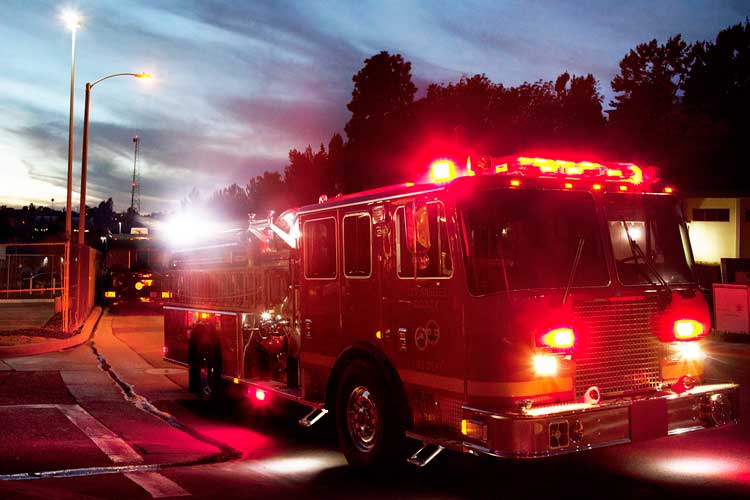
By Bill Adams
The 2021 Fire Department Instructors’ Conference (FDIC) last month offered an excellent opportunity to interact with firefighters, fire apparatus, and component part manufacturers as well as their dealers. I surreptitiously asked many what their opinions were of the proposed changes—or if they had any—in the National Fire Protection Association (NFPA) warning light requirements. Except for a few, most responses were: “It is was it is.” “There isn’t too much we can do about it.” “The NFPA will do what they want.” “It’ll be whatever the manufacturers want.” I was amazed at their comments and for them not having the same degree of warning light enthusiasm that I have. To avoid biased responses, warning light manufacturers were not sought out. [Disclaimer: I do not sell nor work for any manufacturer, and I am no longer an active firefighter.]
My Personal Opinions
Warning lights should tell or influence motorists what to do. Fast-moving lights should indicate I’m coming, get out of the way; slow-moving lights should suggest I’m stopped—don’t run into me; slow-moving and mostly amber lights should be used when stopped. I don’t care how many or what kind of warning lights are used—I do care if they cause motorists discomfort and distraction rather than give a warning.
NFPA Standards 1901 and 1900
Last revised in 2016, NFPA 1901 Standard for Automotive Fire Apparatus is being consolidated with three other standards into one large, comprehensive standard (NFPA 1900) covering structural fire apparatus, ambulances, airport crash trucks, and wildland apparatus. The proposed NFPA 1900 Standard’s second draft is open for public comment. Here’s a link to the NFPA’s website.
There is a formal process where anyone can make suggestions and comments (input) on all NFPA standards. The process nullifies the “can’t do nothing about it” statements made above. I have suggested making changes to NFPA 1901 many times in the past; some were rejected, and some were not. So, it can be done.
The submitted public comments and suggested changes to the new NFPA 1900 standard are accessible at that website. Included are the names and affiliations of those making changes and their justification for making them. And, most importantly, the NFPA committee’s written response to those changes are also there. Nothing is hidden from public view.
The document’s 1,658 pages of proposed changes includes the NFPA committee’s responses as to whether the committee will reject or accept them partially or in total. Supposedly, more than 1,800 public comments were made that the NFPA committee had to address. Public comment on the input and draft document closes on November 12. “Speak now or forever hold your peace.”
Proposed Changes
The 1,658 pages were browsed through only for changes applicable to warning lights. I interpreted most changes are to make the new document easy to read and more understandable than the previous standards. Some actual committee statements include:
- “Added language clarifies what is in an optical warning system.”
- “Clarify that lights from multiple manufacturers can be used, so long as the system is compliant.”
- “This is to clarify that a fire apparatus must have one switch to activate all warning lights, but there are other ways that fire departments might activate certain warning lights, for example: activate lights with transmission in reverse or with a return-to-quarters switch.”
- “Added words provide more clarity to the importance of separation on warning devices from other signaling or illuminating devices for improved conspicuity. FMVSS 108 requires that nothing else impair the FMVSS 108 required lights.”
- “Rearrangement of the words provides more clarity on the objective of……”
Amazing?
Comments and proposed changes were made by end users, manufacturers, industry experts, as well any interested party. There has been skepticism (not an accusation—just an observation) in the industry and fire service that some proposed changes were or might benefit a single manufacturer. The warning light industry is highly competitive. I found it amazing that several of the proposed changes included this notation under the heading of Statement of Problem and Substantiation for Public Input: “Supported by Code-3, Federal, PowerArc, & Whelen.” Cooperation and agreement among warning light rivals for the benefit of the fire service!
Personal Perceptions
It appears the warning light portion of the new NFPA 1900 is very similar to the old 1901 requirements with the minimum optical requirements remaining the same. Green has been approved as a warning light color but can’t be used to meet NFPA standards. I think that means you can use it in addition to the minimum requirements. The slowest flash rate has been reduced from 75 to 60 flashes per minute, which makes people like me happy who prefer slow flash rates when in the blocking-the-right-of-way mode.
For several years there has been talk of mandating warning lights automatically dim at nighttime to reduce glare. I interpret the changes in the current wording has clarified that a warning light system has to have at least two modes of warning (responding and blocking), but it can have more if desired (such as dimming at night). And, the changing of the modes can be either automatic or by manual switching. That seems to be a fair compromise.
The minimum requirements for warning lights were and still are based upon halogen lighting technology. To my knowledge, there is nothing in the current or proposed standards that stipulates an allowable maximum brightness. Consequently, a basic, low-cost, no-frills, non-blinding but compliant warning light system is still allowed. The only problem with simple yet effective lighting systems is the lighting manufacturers may no longer offer them. Also, will vendors and manufacturers push it or the latest, greatest, brightest, and most expensive system available in the western hemisphere?
Warning lights are one of the last items on a fire truck that a fire department can truly customize. Remember, the deadline for public input for proposing changes to any part of NFPA 1900 is November 12. As previously mentioned: “Speak now or forever hold your peace.”

